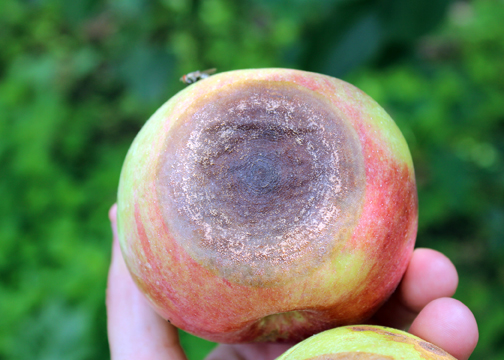UK researchers studying ways to better manage apple disease
UK researchers studying ways to better manage apple disease

Bitter rot is a common harvest-season disease for apples in Kentucky. University of Kentucky plant pathology researchers are studying methods to improve fungicide recommendations to limit losses from this disease.
“We started getting complaints from some of our growers a few years ago about the presence of the disease, even though they were closely following the recommended spray program,” said Nicole Ward Gauthier, extension plant pathologist in the UK College of Agriculture, Food and Environment.
Bitter rot tends to be more prevalent during wet years. It is found on apples hanging on trees as well as in stored fruit. Disease symptoms include dark brown or black spots with a number of slightly raised dark cushions near the centers. These cushions frequently make a target-shaped appearance on fruit and can have slimy pink spores oozing from them.
Gauthier and research analysts Ed Dixon and Bernadette Amsden began studying the fungicide sensitivity of infected apples. They found that the apples had two different fungal species complexes of the pathogen Colletotrichum. One of the complexes was more responsive to fungicides than the other.
Preliminary results from a survey conducted by UK graduate student Misbahkul Munir are beginning to show that southern counties have one species complex and northern counties have another. This is likely due to the difference in climate, as one is a more tropical complex and the other favors more moderate temperatures.
“We will continue the survey a few more years before the results will be conclusive,” Gauthier said. “With more than 1,000 acres of apple trees in the state, we are hoping to collect samples from every county. This information will help us make disease management recommendations that are more precise and effective.”
Gauthier’s lab is also trying to pinpoint when infection occurs in the fruit.
“Infection can occur early in the season, but the disease will not show up until later,” she said. “During warmer years, there’s a possibility that the disease may become active before growers would typically begin spraying.”
Apple growers or homeowners with apples are encouraged send infected fruit to their local office of the UK Cooperative Extension Service for use in these research projects.
Extension Horticulture Research

